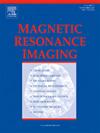Correcting unwanted diffusion weighting in diffusion-weighted-STEAM sequence for time-dependent diffusion kurtosis imaging
IF 2
4区 医学
Q2 RADIOLOGY, NUCLEAR MEDICINE & MEDICAL IMAGING
引用次数: 0
Abstract
Purpose
This study proposes an optimized acquisition protocol to minimize the unwanted diffusion weighting in DW-STEAM and facilitate time-dependent diffusion kurtosis imaging (tDKI).
Methods
We first corrected the diffusion-direction-dependent shift by optimizing the diffusion gradient amplitude. We then proposed to use low-b-value in the reference image, instead of the conventional non-diffusion-weighted (b0) acquisition, and removed the crusher gradients. The tDKI measurements from the proposed strategy were compared with conventional DWIs that included crushers in the b0 image, in a water phantom and in healthy adults (n = 8) on 3 T, and the water exchange time (τex) was calculated from the tDKI measurements. The optimal strategy was tested in five ex vivo human brains, and the results were compared with in vivo data.
Results
Neglecting the diffusion weighting in b0 images introduced an artificial time dependence in the apparent diffusivity of the water phantom, and resulted in elevated estimates of water exchange time (τex) in in the in vivo data. Additionally, the AIC indicated that, even when diffusion weighting in the b0 images was accounted for, the kurtosis estimation remained less stable in the in vivo than with the crusher-free approach. In contrast, using low-b-value images as reference measurements yielded reasonable tDKI estimates, with τex ranging from 15 to 40 ms for gray matter in vivo and from 20 to 60 ms for gray matter ex vivo.
Conclusions
The optimized DW-STEAM acquisition eliminated artificial diffusion-time dependence, enabling the acquisition of accurate tDKI data for mapping structural morphology and transmembrane permeability.
校正时间相关扩散峰度成像中扩散加权- steam序列中不需要的扩散加权
本研究提出了一种优化的采集方案,以最大限度地减少DW-STEAM中不必要的扩散权重,并促进时间相关扩散峰度成像(tDKI)。方法首先通过优化扩散梯度振幅修正扩散方向相关偏移。然后,我们提出在参考图像中使用低b值,而不是传统的非扩散加权(b0)采集,并去除破碎机梯度。将该策略的tDKI测量值与常规dwi进行比较,常规dwi包括b0图像、水幻影和健康成人(n = 8)在3 T中的破碎机,并根据tDKI测量值计算水交换时间(τex)。该优化策略在5个离体人脑中进行了测试,并与体内数据进行了比较。结果忽略b0图像中的扩散权重会导致水影表观扩散率产生人为的时间依赖性,从而导致体内数据中水交换时间(τex)的估计升高。此外,AIC表明,即使考虑了b0图像中的扩散权重,在体内的峰度估计仍然不如无破碎方法稳定。相比之下,使用低b值图像作为参考测量得到了合理的tDKI估计,体内灰质的τex范围为15至40 ms,体外灰质的τex范围为20至60 ms。结论优化后的DW-STEAM采集消除了人为的扩散时间依赖,能够获得准确的tDKI数据,用于绘制结构形态和跨膜渗透率。
本文章由计算机程序翻译,如有差异,请以英文原文为准。
求助全文
约1分钟内获得全文
求助全文
来源期刊

Magnetic resonance imaging
医学-核医学
CiteScore
4.70
自引率
4.00%
发文量
194
审稿时长
83 days
期刊介绍:
Magnetic Resonance Imaging (MRI) is the first international multidisciplinary journal encompassing physical, life, and clinical science investigations as they relate to the development and use of magnetic resonance imaging. MRI is dedicated to both basic research, technological innovation and applications, providing a single forum for communication among radiologists, physicists, chemists, biochemists, biologists, engineers, internists, pathologists, physiologists, computer scientists, and mathematicians.
 求助内容:
求助内容: 应助结果提醒方式:
应助结果提醒方式:


